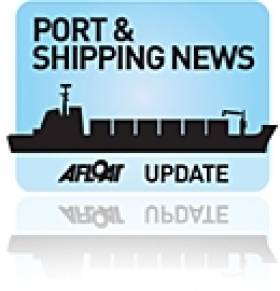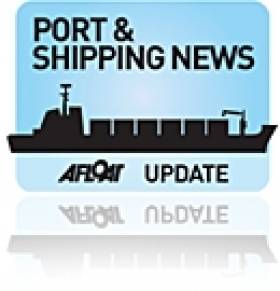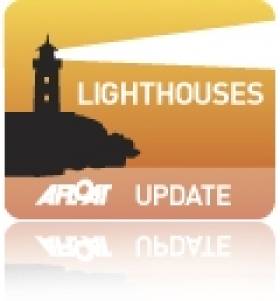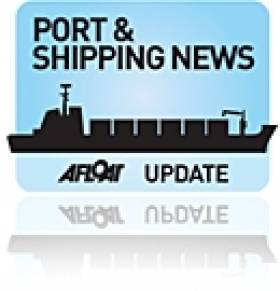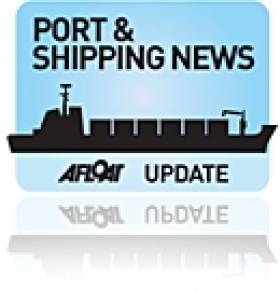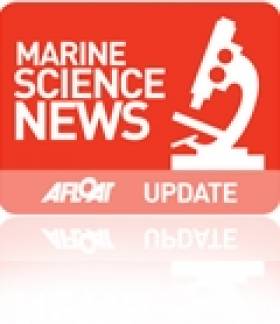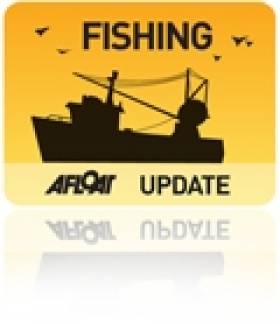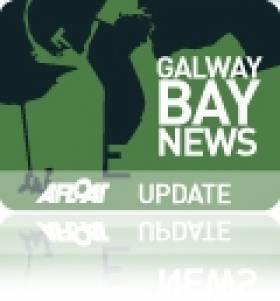Displaying items by tag: Arklow Shipping Ltd
#ArklowNewbuilds – Arklow Bank is to be followed by the second of six new 'B'class 4,800 deadweight tons multi-purpose cargoships, with Arklow Bay to be launched early next month, writes Jehan Ashmore.
As previously reported, the newbuilds are on order from Arklow Shipping Ltd at Ferus Smit's Dutch based shipyard in Westerbroek from where the 119m long leadship Arklow Bank was launched last month.
Her typical 'Arklow' green hull shade and that of her sisters will be even more 'green' in that the hull characteristics and innovative 'bulbless' bow shape brings this design a number of 'environmental' advantages.
The B class have longer and sharper waterlines that create less resistance, irrespective of her loading draft. At the same time this shape creates more deadweight and cargo volume within her absolute dimensions. Above the waterline the more slender form will cut gradually through waves, improving performance in rough conditions.
Arklow Bay has a two-hold grain capacity of 9902,6m³ and for bale of 349.706ft³ . Wheat, corn and other bulk-cargo commodities will form as regular shipments for these vessels while operating in north-western European waters. Powerplant is provided by a Mak engine delivering a maximum 13 knots.
The newbuild is due to be delivered to ASL's Dutch based division, Arklow Shipping Netherland B.V. in April.
To the Manor Born as Arklow Vessel Undergoes Dry-Docking
#DRY-DOCKING –One of the largest vessels of the 40-plus Arklow Shipping Ltd fleet, Arklow Manor of 9,682grt/14,008dwt entered the dry dock in Dublin Port yesterday, writes Jehan Ashmore.
The 139m dry-cargo vessel docked in Graving Dock No.2, though the facility located within Alexandra Basin actually consists of a single facility since the older and smaller adjacent Graving Dock No. 1 was in-filled several years ago to create more hard-standing space for freight vehicles.
Arklow Manor has four holds that can handle various cargoes, among them grain (total capacity of 18,110 m3). She is the lead ship of a five 'M' class vessels that was completed in 2009 from the Mokpo Shipbuilding Ind. Co in South Korea. Earlier this year one of her sisters, Arklow Marsh also underwent dry-docking at the same facility.
Both these vessels belong to a majority of ships (ranging from 3,000 tonnes) that are registered in Arklow, where the company headquarters manage the Irish flagged fleet. The remaining Dutch flagged vessels are managed by Arklow Shipping Nederland based in Rotterdam, which is also the port of registry for these ships.
Another Lightship Extinguished into History
#LIGHTSHIPS – As each day passes, quite literally chunks of Irish maritime heritage are been rapidly consigned to history, as work on scrapping the former lightship ALF Skua takes place on the North Quay in Arklow, writes Jehan Ashmore.
As the vessel lies forlornly alongside her River Avoca berth, a blowtorch cuts away in earnest at the steelwork. In tandem a crane-grabber lifts large sections of the red painted ship and loaded into an awaiting quayside truck.
What remains as of this week is only the hull, as the bridge, deckhouse structure and lantern have gone, having said that the latter structure was removed years ago.
When the lightship was towed into the port, several elected members of Arklow Town Council, with a seafaring back-round prevailed in the public body to acquire the lantern. The structure however still remains yet to be located to an appropriate site, as according to the council they have no definite plans for the lantern, though it is envisaged that it would be at least placed in a municipal location.
For decades the lightship served several stations off the Irish coastline, having been completed in 1960 by Philip & Sons of Dartmouth for the Commissioners of Irish Lights (CIL). Constructed of steel, the 134 foot lightship, cost £124,128 when launched in the Devon shipyard, though her crew were replaced when converted to an automatic light float (ALF) in 1981/82.
The vessel's designation as an ALF lasted for more than two decades until Irish Lights sold the lightship to Arklow Shipping Ltd in 2005, however she has since changed hands while moored in the Co. Wicklow port.
Nearby to where the Skua is berthed, a lantern belonging to an older lightship fleetmate, the Albratross (built 1925), was kept to form a distinctive landmark at the entrance to Arklow Marina.
With the diminishing Skua, it is believed that only two such ships survive on this island. The ALF Kittiwake (built 1959) as previously reported on Afloat.ie is in Dublin Port, however she shifted berths several months from her prominent position opposite the 02 Theatre to the jetty within Alexandra Basin, which is hidden away from general view in the working port.
The other lightship the Petrel, was built by Dublin Dockyard between 1913-15. She remains as a floating clubhouse for the Down Cruising Club in Strangford Lough, having been towed to the lough by the lighthouse tender ILV Isolda during the late 1960's.
As for the last lightship to serve, the honour was left to the ALF Gannet. She was stationed at South Rock, off Co. Down until her decommissioning in 2009 when Irish Lights replaced the lightship with a new 'Superbuoy'.
Newbuilds Expand Arklow Shipping Fleet
#NEWBUILDS-Two of the latest newbuilds for Arklow Shipping, one built in Spain and the second ship comleted from a South Korean shipyard, both entered service late last year and raises the fleet total to 44 vessels.
The northern Spanish built Arklow Forest became the 10th 'F' class vessel which was launched from Astilleros de Murueta SA. She is a 2,998grt vessel with a single-box hold with two portable bulkheads which can be placed into 10 positions for cargo separation. Her main engine plant is a MAN 6L27/38 2040kW gearbox with CPP, delivering about 12 knots.
Also entering service in late 2011 the Arklow Moor a 13,975dwt newbuild which formed the fifth in the series of 'M'-class vessels and she was built in South Korea by the Mokpo Shipyard Corporation. The class have four holds with a total grain capacity of 18,110 m3. They are fitted with a MaK 6M 43C main engine, 5,400kW, Jake reduction gearbox and Rolls Royce CPP which delivers about 14 knots.
Both newbuilds are registered in their owner's homeport and are Irish flagged. Of the 44-strong fleet, the majority of vessels (34) are managed by Arklow Shipping and the balance of vessels (11) are run by Arklow Shipping N.V.
Arklow Shipping Expands Fleet into Handysize Bulker Market
#PORTS & SHIPPING – Arklow Shipping is further expanding its bulker fleet and moving into the market for larger vessels with an order for three ships in South Korea, according to Tradewinds.
The company which is headquartered in the Co. Wicklow port has booked two 35,000-dwt handysize-bulkers and a general cargoship at Daesun Shipbuilding. TradeWinds sources say Arklow is paying a premium for the ships against more competitive pricing from China.
Brokers price the Daesun bulkers at around $25.5m, which compares to similar deals in China at around $22m. As for the general cargoship, she will be delivered in the first half of 2013 and the bulkers in the second half of the year. Arklow previously signed up for a series of 14,000-dwt multipurpose (MPP) vessels at Mokpo, which later went into administration.
The orders were then passed on to Sekwang Shipbuilding only for it also to fall into financial difficulties. Daesun has had its problems too and was delisted from the Seoul Stock Exchange in April as it did not meet the bourse's financial requirements.
The latest order appears to have taken Arklow's owned fleet into the larger-handysize segment. So far it has focussed mainly on bulkers, general-cargo and MPP ships up to 14,000 dwt. It has a fleet of 55 ships including 12 newbuildings, most of which are registered in the Republic of Ireland. Arklow declines to comment on the Daesun order.
New Arklow Bulker Docks In Dublin to Load at Tara Mines Facility
She has a gross tonnage of 2,998 and a single-box hold with two portable bulkheads which can be placed into 10 positions for cargo separation. At 4,800 dwt, ship is certified for the carriage of dangerous goods of IMO Class 4.1, 4.2, 4.3, 5.1 and 5.2 (packaged) as well as general bulk cargoes. The main engine is a MAN 6L27/38 2040kW gearbox with CPP, delivering about 12 knots.
The 89m Arklow Forest was one of the 4,500 dwt 'R' class designs but was modified to allow carriage of a further 300 tonnes of cargo. She follows Arklow Field (PHOTO) which entered service this year and to read a report on another F class, Arklow Future click HERE.
Arklow Shipping Ltd with its headquarters in Co. Wicklow operate the fleet which in the majority are Irish registered. Some vessels though are managed through Dutch subsidiary Arklow Shipping Netherland B.V. based in Rotterdam where they are also registered in that port.
Taoiseach Announces Marine Jobs On Visit of RV Celtic Explorer
An Taoiseach Enda Kenny visited the Marine Institute's research vessel RV Celtic Explorer in Dublin Port today, where he announced the creation of 92 jobs in the marine sector, writes Jehan Ashmore.
"Ireland is now recognised as an emerging power in Marine Research and Innovation," said the Taoiseach. Of the new positions, 64 will be generated in the seafood processing sector. This follows a €3.5m Seafood Processing Business Investment Scheme administered by Bord Iascaigh Mhara (BIM). In the area of marine research, 28 jobs have been created through funding of €2m from an International SmartOcean Graduate Programme.
SmartOcean is a collaboration between IRCSET (Irish Research Council for Science Engineering and Technology), the Marine Institute, five Irish universities and key multinationals and SME Information and Communication Technology (ICT) companies to provide funding for 28 research posts.
The Taoiseach said: "This has been achieved through the mapping of the 90% of Irish national territory that lies under the Atlantic, the creation of a quarter of a billion Euros worth of marine research infrastructure, and the fostering of strong linkages between industry and research centres, all of which will support employment opportunities in key areas of potential growth in the marine sector."
During the tour of the RV Celtic Explorer, the Taoiseach who was accompanied by Minister for Agriculture, Marine and Food, Simon Coveney, welcomed the expansion of Ireland's capabilities in the international shipping services sector, which is expected to attract additional jobs to the country.
Ireland's emerging international shipping services sector has continued to grow, underpinned by a number of investments in new and second hand ships over the last twelve months by such companies as Arklow Shipping and the Mainport Group, as well as foreign direct investments by D'Amico and Ardmore shipping.
As reported on Afloat.ie, RV Celtic Explorer had arrived yesterday into Dublin Port, having completed a fisheries demersal survey which started in Galway on 23 September. Initially she had docked at Ocean Pier but she subsequently shifted berths to Sir John Rogersons Quay for today's reception of An Taoiseach. According to her survey schedule she is due to depart tomorrow on a herring acoustic survey which is to take place in the Celtic Sea and off the south-west coast.
- Dublin Port
- BIM
- Marine Institute
- marine science
- Arklow Shipping Ltd
- Bord Iascaigh Mhara
- Ports and Shipping News
- Ardmore Shipping
- Mainport Group
- D'Amico
- Irish marine jobs
- An Taoiseach Enda Kenny
- SmartOcean
- RV Celtic Explorer
- RV Celtic Voyager
- Sir John Rogersons Quay
- Irish research vessels
- Simon Coveney
‘Angelus’ Trawler Also Appears On Pierside Gallery
Apart from the mural of the trawler (click HERE) there are a wide variety of vessels represented from general cargo-ships and the inclusion of STV Asgard II and the World's last ocean-going paddle-steamer P.S. Waverley. These vessels have too berthed alongside the adorned eastern breakwater where spectators flock to see the start of the biennial Round Ireland Yacht Race which was held last year.
The photo of the trawler was taken on a previous call at the Packet Quay, Wicklow and not Arklow as stated. The Packet Pier is the most used commercial quay in the Co. Wicklow port, where timber and scrap-metal cargoes are relatively common. For example the Arklow Rebel which loaded scrap-metal bound for Liverpool, to read more click HERE.
Three’s A Crowd as Naval, Research and Cargo Ships Dock In Galway
Also sharing the basin but located closer to the dock gates was Arklow Shipping Ltd's Dutch registered dry-cargo vessel Arklow Surf (2000/2,316grt). The dock is capable of handling more vessels simultaneously and of course used as a host-port of the high-profile Volvo Ocean Race which is due to return next year.
Galway and neighbouring Limerick City with its Ted Russell Dock, are the only dock-gate accessed ports on the island of Ireland. In the case of Galway there is an exception as freight operations are also available from an outer pier on the seaward side of Dún Aengus Dock though only for domestic purposes. From this pier the dedicated Aran Islands freight service is operated by Lasta Mara TEO's Blath na Mara (1983/330grt). As for Limerick, vessels can also berth outside the dock but they tend to be small port-work related craft that use the outer berth on the Shannon Estuary.
The Galway Harbour Company in recent years have proposed plans for a new outer port, to be built in four stages with a completion date set for 2017. This would enable larger deeper drafted vessels such as tankers and cruiseships to dock in the new port. In the meantime cruiseships anchor off Mutton Island. In addition a freight rail-link, berthing for an inshore fishing fleet and a 216 berth marina are proposed.
To read more about the port proposals visit http://www.galwayharbour.com/news.php?id=11and for aerial visual impressions click HERE.
- River Shannon
- Marine Institute
- naval service
- Ports and Shipping
- Arklow Shipping Ltd
- Ports and Shipping News
- Aran Islands
- Island News
- Galway Bay News
- Marine Science News
- Dun Aengus Dock
- Galway Harbour Company
- Cruise Liner news
- Cruise ships
- Galway Harbour and Bay news
- Ted Russell Dock
- Marine Instistute Research vessels
- Lasta Mara TEO
New €1.5m Rail-Spur for Dublin Port
The minister welcomed "the important investment by Dublin Port Company in its rail network. It will further enhance the attractiveness of the port as a destination for rail-based freight. The project represents a commitment on the part of Dublin Port Company and Iarnród Éireann to customers who want to move goods by rail".
The project took six months to complete and the public private partnership involved Dublin Port Company, Iarnród Éireann and the first customer of the new facility, International Warehousing and Transport (IWT).
IWT is a privately owned Irish logistics company, which already operates freight-trains to Ballina that are expected to increase from 4 to 5 trains per week in each direction as a result of this investment. The rail-operator believes that the service will save up to 5.5million road kilometres annually and reduce CO2 emissions by up to 2,750 tonnes.
The Irish Exporters Association also welcomed the development of the IWT freight operation at the new facility, where increased frequency in services will enhance Ireland's contribution to the European Union's modal shift aspirations from road to rail.
The Common User Terminal is also open to other shipping companies. Existing clients using the lo-lo container terminal operated by Burke Shipping Group through its subsidiary Portroe Stevedores are C2C Lines, APL, Coastal Containers, Evergreen, Gracechurch and OOCL . The terminal also has a ro-ro berth facility where CLdN /Cobelfret operate from on routes to Belgium and The Netherlands.
In addition to the Dublin-Ballina service the port exports 400,000 tonnes of lead and zinc concentrate from the freight customers Boliden/Tara Mines with 15 trains per week. The facility at Alexandra Basin Jetty is regularly served by vessels from Arklow Shipping Ltd, where the 2011 newbuild Arklow Field (2,998 tonnes) is currently berthed.
- Dublin Port
- Dublin Port Company
- Arklow Shipping Ltd
- Irish Exporters Association
- Port of Dublin
- Ports and Shipping News
- IEA
- Minister for Transport
- Ocean Pier
- Irish Rail
- Iarnrod Eireann
- Portroe Stevedores
- Dublin Port news
- IWT
- ASL
- Leo Varadkar T.D.
- Port of Dublin news
- Railfreight
- International Warehousing and Transport
- Alexandra Basin East
- Common User Terminal
- Burke Shipping Group
- Clnd Cobelfret
- Boliden
- Tara Mines
- Arklow Field
- Dublin Shipping
- Lead mines
- Zinc mines
- Irish Railways
- Dublin Port railhead


























